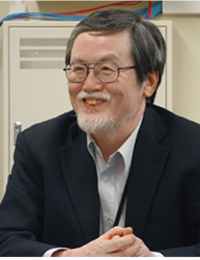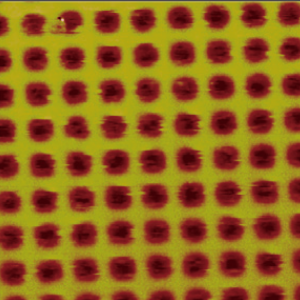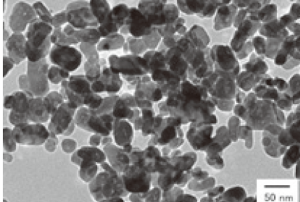キーワード: スピントロニクス、磁気記録、省エネルギー、元素戦略
 電子にはスピンと呼ばれる性質があり、原子を構成する電子のスピンの向き(上向き、下向き)と個数により、鉄(Fe)などの元素の磁性が発現します。工学的にスピンと電荷の両方を利用する分野がスピントロニクスと名付けられ、固体物性の一分野となっています。本リサーチユニットでは、極微小領域のスピンを精密に制御して新しい特性を生み出し、さらに電流や抵抗を制御したり、逆にスピンを電流で制御したりして新しい材料系を生み出そうとするものです。ユニットには、磁化反転の高時間分解能計測、半導体とスピンの接合、理論的なスピン伝導、さらには磁性薄膜形成を研究対象とするメンバーが含まれ、基礎から実用化まで広範囲な内容を扱っています。
電子にはスピンと呼ばれる性質があり、原子を構成する電子のスピンの向き(上向き、下向き)と個数により、鉄(Fe)などの元素の磁性が発現します。工学的にスピンと電荷の両方を利用する分野がスピントロニクスと名付けられ、固体物性の一分野となっています。本リサーチユニットでは、極微小領域のスピンを精密に制御して新しい特性を生み出し、さらに電流や抵抗を制御したり、逆にスピンを電流で制御したりして新しい材料系を生み出そうとするものです。ユニットには、磁化反転の高時間分解能計測、半導体とスピンの接合、理論的なスピン伝導、さらには磁性薄膜形成を研究対象とするメンバーが含まれ、基礎から実用化まで広範囲な内容を扱っています。
磁気記録媒体への応用

図1:スピネル強磁性体のイオン照射によるパターン形成の例。(磁気力顕微鏡写真)
マグネタイト薄膜にKr イオンを照射して、図の明るい部分を非磁性化した。
日常生活で馴染みの深いハードディスクは磁性材料が基本となっています。従来型の面内方向に磁性をもつものでは、1 ビットのサイズが100 nm □程度であったものが、磁性を面内に垂直にした垂直磁気記録では1 ビットあたり10 nm□オーダーになろうとしています。ここまで微細化(高密度化)すると、磁化が(室温でも)熱エネルギーで揺らぎを生じて、エラーを起こしてしまいます。このような極限領域でも安定動作させるためには、材料、プロセスの基礎から研究開発を行う必要があります。材料では貴金属を使わないフェライトの利用、プロセスでは材料自身による自己組織化の利用やイオン照射技術の応用などが考えられています。ユニットでは現在使用されているCoCrPt 合金や次世代の材料と考えられるFePt 合金のようなPt を含む材料に替わる材料として、記録材料として十分な性能を持つCo フェライト(CoFe2O4) 薄膜を開発しました。図1 には、Kr イオンを照射したマグネタイト(Fe3O4)薄膜を示しますが、明るい部分が非磁性化されていて、この手法でスピネルフェライトのビットパターン化ができることが分かります。研究段階ではパターンのサイズが大きく、実用に至るにはさらなるパターンの微細化と材料の選択が必要です。このような新材料開発技術を実用化レベルにするには、マスプロダクツ技術を有するメーカーとの共同での研究開発が必要となります。
磁性粒子の医療への応用やスピントロニクス

図2:ガン治療用に開発した高い発熱能力を持つ楕円板
状の磁性ナノ粒子。
磁気記録媒体は、薄膜構造を基本にしています。本ユニットでは、次元数を下げたナノ粒子をスピンを有する材料で作り、その応用を試みています。図2 には、Fe3O4 で構成される直径20nm のパーティクルを示します。このパーティクルにガイド分子を付加させて、特定の細胞(癌細胞)に到達させることが可能となります。この特定部位を含む組織を磁場中に置くことにより、局部的に高温発熱させ、癌細胞を焼ききってしまう応用展開が考えられています。ここでは、磁性を有する材料を磁場中に置くことで発生する電流が熱に変換する基本原理を利用しています。ユニットでは1g あたり1 kW の発熱が可能な高性能発熱粒子を開発しました( 図2)。
また今後、大きな研究の広がりが期待されるスピントロニクス分野でも、ユニット内のメンバーは精力的な研究を行っています。磁石の運動の基本原理を探ることが可能になる1000 兆分の1 秒の電子スピン運動を捉える顕微鏡の開発(重川グループ)や新しいエレクトロニクス素子を目指す半導体スピントロニクス(黒田グループ)、窒化物スピントロニクス(末益グループ)、理論(佐野グループ)の分野で成果を上げています。
社会への貢献・実績
- Pt を含まないハードディスク記録材料の実用化
- Co フェライト薄膜で実現した高い磁気異方性の発表( Applied Physics Letters誌、および新聞発表)
- 元素戦略プロジェクト研究
- 大学院生が2014 年磁気学会での講演賞、研究員が応用物理学会のポスター講演で受賞
取材:平成27年5月1日
Magnetism Research in Ultrafine Fields and Its Application
Unit name:Nano Spin
Key words: spintronics, magnetic record, energy saving, element strategy
 Electrons have a nature called “spin.” Depending on the direction (upward or downward) and the number of electron spins, elements, such as iron (Fe), express magnetism. The research field which utilizes both spin and electric charge by techniques of engineering is called “spintronics,” one of the fields of solid state physics. Our research unit is aimed at creating new characteristics through precise regulation of the ultrafine field, and at creating new materials though control of electric current and resistance or, conversely, through control of spins by means of electric current. The members constituting this unit include those conducting research on high temporal resolution measurement of magnetization reversal, semiconductor-spin binding, theoretical spin conduction, or magnetic film formation. Thus, this unit has wide coverage, ranging from basic to applied fields.
Electrons have a nature called “spin.” Depending on the direction (upward or downward) and the number of electron spins, elements, such as iron (Fe), express magnetism. The research field which utilizes both spin and electric charge by techniques of engineering is called “spintronics,” one of the fields of solid state physics. Our research unit is aimed at creating new characteristics through precise regulation of the ultrafine field, and at creating new materials though control of electric current and resistance or, conversely, through control of spins by means of electric current. The members constituting this unit include those conducting research on high temporal resolution measurement of magnetization reversal, semiconductor-spin binding, theoretical spin conduction, or magnetic film formation. Thus, this unit has wide coverage, ranging from basic to applied fields.
Application to magnetic recording media

Fig. 1: An example of patterning by ion irradiation to highly magnetic spinel material. (Magnetic force micrograph) Kr ion applied to the magnetite film, to make it nonmagnetic (the bright part).
Hard disks, which are familiar in our daily lives, are based on magnetic materials. Conventional hard disks with magnetism in the In-plane direction had a bit size of about 100 nm□, but the recently developed vertical recording hard disks, have magnetism perpendicular within the plane, with a bit size approaching the order of 100 nm□. With such ultrafine (ultrahigh density) hard disks, magnetization can fluctuate under the influence of thermal energy (even at room temperature), leading to errors. To achieve stable functioning under such extreme conditions, research and development covering the fundamental aspects of processes is needed. As far as materials for preparation of hard disks are concerned, disks made of ferrite, without using any precious metals, are now being considered. Regarding the processes, utilization of material’s self-organization, application of ion irradiation technology, and so on are now being considered. At our unit, Co ferrite (CoFe2O4), which has sufficient performance as a recording material, has been developed to replace the currently used CoCrPt alloy and the Pt-based materials (FePt alloy, etc.), and are now considered next-generation materials.
Fig. 1 illustrates the magnetite (Fe3O4) film after Kr ion irradiation. The bright part is nonmagnetic, indicating that this technique enables bit patterning of spinel ferrite. This film at the research stage has a too large pattern size, and it is necessary to reduce the pattern size, and to select a more appropriate material, so that a commercially applicable film can be prepared. To advance such new material development technology to the commercial level, joint R&D with manufacturers with mass production technology is needed.
Medical application of magnetic particles and spintronics

Fig. 2: Magnetic nanoparticles of oval plate form with high heat-generating capability developed for cancer treatment.
Magnetic recording media are based on film structure. At this unit, attempts have been made to prepare and apply nanoparticles of a lower number of dimensions made of spinning materials. Fig. 2 shows a particle of 20 nm in diameter made of Fe3O4. If a guide molecule is added to this particle, the particle can reach specific cells (cancer cells). A possible scene of applying this technology is that cancer cells are burnt completely by the high temperature (heat) locally created by placing the tissue containing this specific particle into a magnetic field. This utilizes the basic principle that placement of a magnetic material in a magnetic field leads to conversion of the generated electric current into heat. Our unit has developed high performance, heat-generating particles capable of generating 1kW heat per g (Fig. 2).
Our unit members have been conducting research actively also in the field of spintronics, which is expected to develop extensively. Noteworthy outcomes obtained to date pertain to development of a microscope capable of detecting electron spinning of 1/1000 trillion seconds, expected to be useful in exploration of the fundamental principle of magnet movements (Shigekawa Group), semiconductor spintronics aimed at new electronic elements (Kuroda Group), nitride spintronics (Suemasu Group), and theoretical research (Sano Group).
Social contributions and achievements
- Commercialization of Pt-free recording materials for hard disks
- Publication of high magnetic anisotropy achieved by ferrite film (Applied Physics Letters, and newspapers)
- Element strategy project research
- Our graduate student got an award for a presentation made at the meeting of Magnetics Society of Japan in 2014, and one of our researchers got an award for a poster presentation at a meeting of the Japan Society of Applied Physics.
Interviewed on May 1, 2015
